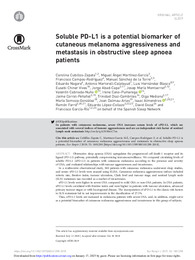Título :
Soluble PD-L1 is a potential biomarker of cutaneous melanoma aggressiveness and metastasis in obstructive sleep apnoea patients |
Autor :
Cubillos-Zapata, Carolina 
Martínez-García, Miguel Ángel 
Campos-Rodríguez, Francisco
Sánchez de la Torre, Manuel
Nagore, Eduardo 
Martorell-Calatayud, Antonio
Hernandez Blasco, Luis M. 
Chiner, Eusebi 
Abad Capa, Jorge 
Montserrat, Josep María
CABRIADA, VALENTIN 
Cano-Pumarega, Irene 
corral-peñafiel, jaime 
Díaz-Cambriles, Trinidad 
Mediano, Olga |
Editor :
European Respiratory Society |
Departamento:
Departamentos de la UMH::Medicina Clínica |
Fecha de publicación:
2019 |
URI :
https://hdl.handle.net/11000/35173 |
Resumen :
Obstructive sleep apnoea (OSA) upregulates the programmed cell death-1 receptor and its ligand (PD-L1) pathway, potentially compromising immunosurveillance. We compared circulating levels of soluble PD-L1 (sPD-L1) in patients with cutaneous melanoma according to the presence and severity of OSA, and evaluated relationships with tumour aggressiveness and invasiveness.In a multicentre observational study, 360 patients with cutaneous melanoma underwent sleep studies, and serum sPD-L1 levels were assayed using ELISA. Cutaneous melanoma aggressiveness indices included mitotic rate, Breslow index, tumour ulceration, Clark level and tumour stage, and sentinel lymph node (SLN) metastasis was recorded as a marker of invasiveness.sPD-L1 levels were higher in severe OSA compared to mild OSA or non-OSA patients. In OSA patients, sPD-L1 levels correlated with Breslow index and were higher in patients with tumour ulceration, advanced primary tumour stages or with locoregional disease. The incorporation of sPD-L1 to the classic risk factors to SLN metastasis led to net improvements in the classification of 27.3%.Thus, sPD-L1 levels are increased in melanoma patients with severe OSA, and, in addition, might serve as a potential biomarker of cutaneous melanoma aggressiveness and invasiveness in this group of subjects.
|
Tipo de documento :
info:eu-repo/semantics/article |
Derechos de acceso:
info:eu-repo/semantics/openAccess
Attribution-NonCommercial-NoDerivatives 4.0 Internacional |
DOI :
10.1183/13993003.01298-2018 |
Publicado en:
European Respiratory Journal. 2019 Jan 31;53(2):1801298 |
Aparece en las colecciones:
Artículos Medicina Clínica
|

 La licencia se describe como: Atribución-NonComercial-NoDerivada 4.0 Internacional.
La licencia se describe como: Atribución-NonComercial-NoDerivada 4.0 Internacional.
.png)